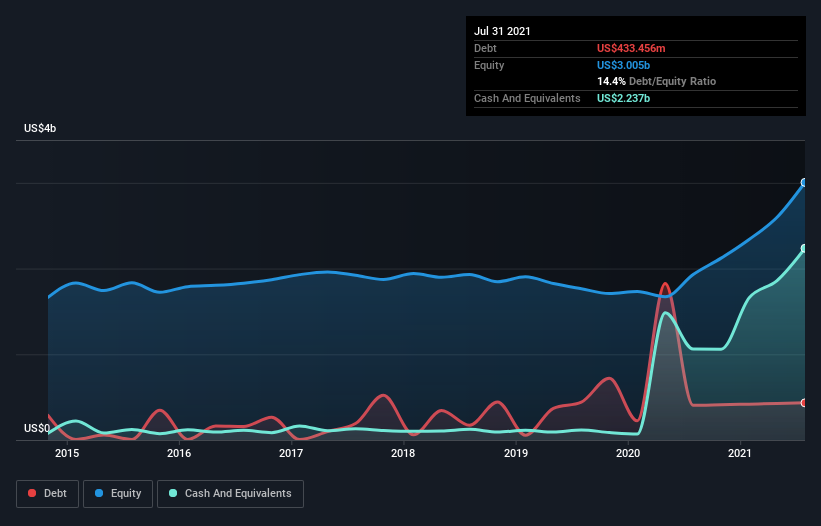DICK'S Sporting Goods (NYSE:DKS) Seems To Use Debt Rather Sparingly
Howard Marks put it nicely when he said that, rather than worrying about share price volatility, 'The possibility of permanent loss is the risk I worry about... and every practical investor I know worries about.' So it seems the smart money knows that debt - which is usually involved in bankruptcies - is a very important factor, when you assess how risky a company is. As with many other companies DICK'S Sporting Goods, Inc. (NYSE:DKS) makes use of debt. But the real question is whether this debt is making the company risky.
Why Does Debt Bring Risk?
Generally speaking, debt only becomes a real problem when a company can't easily pay it off, either by raising capital or with its own cash flow. In the worst case scenario, a company can go bankrupt if it cannot pay its creditors. However, a more common (but still painful) scenario is that it has to raise new equity capital at a low price, thus permanently diluting shareholders. Having said that, the most common situation is where a company manages its debt reasonably well - and to its own advantage. The first step when considering a company's debt levels is to consider its cash and debt together.
Check out our latest analysis for DICK'S Sporting Goods
How Much Debt Does DICK'S Sporting Goods Carry?
You can click the graphic below for the historical numbers, but it shows that as of July 2021 DICK'S Sporting Goods had US$433.5m of debt, an increase on US$404.6m, over one year. However, it does have US$2.24b in cash offsetting this, leading to net cash of US$1.80b.
A Look At DICK'S Sporting Goods' Liabilities
We can see from the most recent balance sheet that DICK'S Sporting Goods had liabilities of US$2.57b falling due within a year, and liabilities of US$2.81b due beyond that. On the other hand, it had cash of US$2.24b and US$89.4m worth of receivables due within a year. So its liabilities outweigh the sum of its cash and (near-term) receivables by US$3.05b.
This deficit isn't so bad because DICK'S Sporting Goods is worth a massive US$11.6b, and thus could probably raise enough capital to shore up its balance sheet, if the need arose. However, it is still worthwhile taking a close look at its ability to pay off debt. While it does have liabilities worth noting, DICK'S Sporting Goods also has more cash than debt, so we're pretty confident it can manage its debt safely.
Better yet, DICK'S Sporting Goods grew its EBIT by 266% last year, which is an impressive improvement. That boost will make it even easier to pay down debt going forward. When analysing debt levels, the balance sheet is the obvious place to start. But it is future earnings, more than anything, that will determine DICK'S Sporting Goods's ability to maintain a healthy balance sheet going forward. So if you're focused on the future you can check out this free report showing analyst profit forecasts.
But our final consideration is also important, because a company cannot pay debt with paper profits; it needs cold hard cash. While DICK'S Sporting Goods has net cash on its balance sheet, it's still worth taking a look at its ability to convert earnings before interest and tax (EBIT) to free cash flow, to help us understand how quickly it is building (or eroding) that cash balance. Over the last three years, DICK'S Sporting Goods recorded free cash flow worth a fulsome 99% of its EBIT, which is stronger than we'd usually expect. That puts it in a very strong position to pay down debt.
Summing up
Although DICK'S Sporting Goods's balance sheet isn't particularly strong, due to the total liabilities, it is clearly positive to see that it has net cash of US$1.80b. And it impressed us with free cash flow of US$1.4b, being 99% of its EBIT. So is DICK'S Sporting Goods's debt a risk? It doesn't seem so to us. The balance sheet is clearly the area to focus on when you are analysing debt. But ultimately, every company can contain risks that exist outside of the balance sheet. Be aware that DICK'S Sporting Goods is showing 4 warning signs in our investment analysis , and 1 of those shouldn't be ignored...
When all is said and done, sometimes its easier to focus on companies that don't even need debt. Readers can access a list of growth stocks with zero net debt 100% free, right now.
This article by Simply Wall St is general in nature. We provide commentary based on historical data and analyst forecasts only using an unbiased methodology and our articles are not intended to be financial advice. It does not constitute a recommendation to buy or sell any stock, and does not take account of your objectives, or your financial situation. We aim to bring you long-term focused analysis driven by fundamental data. Note that our analysis may not factor in the latest price-sensitive company announcements or qualitative material. Simply Wall St has no position in any stocks mentioned.
Have feedback on this article? Concerned about the content? Get in touch with us directly. Alternatively, email editorial-team (at) simplywallst.com.

 Yahoo Finance
Yahoo Finance 
